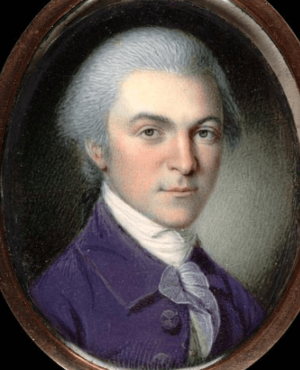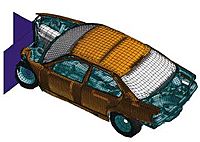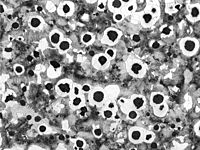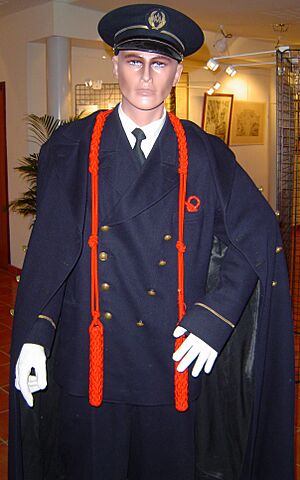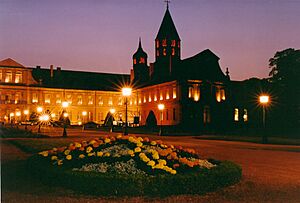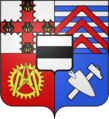Arts et Métiers ParisTech facts for kids
 |
|
|
Former names
|
ENSAM (École nationale supérieure d'arts et métiers), École impériale d'arts et métiers, Ecole d'arts et métiers |
|---|---|
| Type | Public, Grande école |
| Established | 1780 |
|
Academic affiliations
|
ParisTech, France AEROTECH, CGE |
| Budget | €124.6 M (in 2011) |
| President | Laurent Champaney |
|
Academic staff
|
600 |
| Students | 6200 |
| Location |
Paris
,
France
48°50′03″N 2°21′27″E / 48.8341°N 2.3575°E |
| Campus | Paris, Aix-en-Provence, Angers, Lille, Bordeaux, Châlons-en-Champagne, Cluny, Metz |
| Institutes | Bastia, Chambéry, Chalon-sur-Saône |
| Colors | Purple & orange |
| Nickname | Gadzarts |
Arts et Métiers ParisTech is a famous French school for engineering and research. It's known as a "grande école", which means it's a top-level school. It's especially good at teaching about mechanics and how to make things in factories.
Started in 1780, it's one of France's oldest and most respected engineering schools. It's often in the top ten engineering schools in France. In 2018, it was ranked fifth in France for Mechanical Engineering by the Shanghai ranking.
The school has trained 85,000 engineers since it was founded by François Alexandre Frédéric, duc de la Rochefoucauld-Liancourt. It is a public institution overseen by the Ministry of Higher Education and Research. The school was originally called École nationale supérieure d'arts et métiers (ENSAM). In 2007, it started using the name "Arts et Métiers ParisTech".
Arts et Métiers ParisTech has eight teaching and research centers. It also has three special institutes located across France. Students at the school are called Gadz'Arts.
Contents
A Look at Arts et Métiers History
How the School Started
The school began in Liancourt, France, in 1780. It was founded by the Duke of Rochefoucauld-Liancourt. At first, it was meant to train the children of military officers. After 1800, it became known as the École d'Arts et Métiers.
Under Napoleon's rule, it was called the "École impériale des arts et métiers". Napoleon wanted the school to train "Non-commissioned officers of Industry". In 1799, the school moved to Compiègne. Napoleon later decided to move it again in 1806. He chose Châlons-en-Champagne, where two old monasteries offered much more space.
Arts et Métiers During World Wars
Many students and former students joined the army during World War I. About 6,500 Gadz'Arts fought, and 1,100 died in the first year. Many school campuses were damaged, especially the one in Châlons-sur-Marne. The Lille campus was used as a military hospital by the Germans. Other campuses closed from 1916 to 1917. The new Paris campus was not damaged.
Between the wars, Europe's fast industrial growth helped the Gadz'Arts. Industries needed more engineers, and Gadz'Arts were a perfect fit. They quickly filled middle and upper management jobs. This was especially true in the car, airplane, and construction industries.
During World War II, the school tried to keep operating. Only the Lille and Châlons-sur-Marne campuses faced big problems. No new students were accepted in 1939. In 1943, many students and staff from the Cluny campus were taken away. The death of Jacques Bonsergent became a symbol of resistance during the conflict.
Growing and Adding Campuses
The second school of this type opened in 1804 in Beaupréau. It then moved to Angers in 1815. Thirty years later, a third school was built in Aix-en-Provence in 1843. It used old army buildings and monasteries.
Around 1900, the school added three new campuses. In 1891, the old abbey of Cluny became the fourth school. Then, to keep up with the industrial revolution, a fifth campus was built in Lille. The Lille campus was the first one designed specifically for the school. The Paris campus, a long-planned project, was built between 1906 and 1912. It became the biggest campus, but World War II delayed its full opening. By the end of the war, it had over 500 students.
In the 1960s, the seventh campus was created near Bordeaux. It was built in the science park of Talence and opened in 1963.
The newest campus was established in Metz in 1997. It was built in the science park, close to transport links. The school wanted this campus to be international, being near Belgium, Luxembourg, and Germany. It also helped with partnerships with German and American universities.
Between 1990 and 2000, three research institutes were created. These were in Chambéry (1994), Chalon-sur-Saône (1997), and Bastia (2000). The school also has two smaller campuses in Bouc-bel-Air and Laval. These are linked to the main campuses of Aix-en-provence and Angers. They support the school's research programs and labs.
Important Moments in Time
In 1817, the school stopped being military by royal order. Its new goal was to train skilled technicians. However, students still wore uniforms, a tradition that continues today. In 1826, another royal order fully removed the military organization. Students were allowed to wear their uniforms as civil clothing.
After a third try, students gained the right to form an alumni association in 1847. The regional campuses became engineer training institutions in 1907. In 1963, the school changed its curriculum. It started recruiting students from special preparatory classes. In 1964, Nicole Laroche became the first woman to join Arts et Métiers. The school became a "grande école" in 1976. It received its current public institution status in 1990.
In 2007, the school joined ParisTech and adopted the name "Arts et Métiers ParisTech". It stopped using "ENSAM" in its publications. In 2016, it removed "ParisTech" from its logo.
Logos and Symbols of the School
At first, the school didn't have its own logo. It shared a symbol with the Duke and the city of Liancourt. This symbol had the letters A and M inside a gear. Over time, with different governments, the school's visual identity changed often. It used the imperial eagle under Napoleon, then a royal flower when the monarchy returned.
Eventually, students decided to create their own symbol. This symbol showed the letters A and M linked together. It was inspired by the Liancourt symbol. Students still use it today, though it was updated slightly in the 1950s. The alumni association's first logo was also inspired by Liancourt. Later, it adopted the students' version.
In 1963, a new, modern logo was designed for the school. It was very different but still kept the letters A and M. In 2007, with the creation of ParisTech, the school made a brand new logo. This time, the letters are not written. Instead, they can be seen in the shapes of purple and orange diamonds. The school's new name is written next to the diamonds.
School Rankings and Facts
Arts et Métiers ParisTech is always ranked among the top ten French engineering schools. This is true for starting salaries, research, and international chances. It's considered one of the top 5 "Grandes écoles" for students coming from preparatory classes.
Here are some key facts about the school:
- 1,100 engineering degrees given out each year. These are like Master's degrees in mechanical and industrial engineering.
- 6,200 students currently studying there.
- 33,000 former students around the world.
- 400 professors and 250 full-time researchers.
- 200 industrial consultants.
- 600 technicians and administrative staff.
- 15 laboratories and research teams.
- 220 PhD students.
- A total budget of 125 million Euros.
The school's Master of Sciences in Engineering was ranked 34th by DAUR Rankings in 2022.
What Arts et Métiers Teaches
The main goal of Arts et Métiers ParisTech is to teach general engineering skills. This includes mechanical, structural, electrical, and industrial engineering. The school also offers ongoing training for engineers and industry leaders.
With 15 research labs and two PhD programs, the school focuses on three main areas:
- Mechanics, materials, and manufacturing processes.
- Systems that use fluids and energy.
- Designing, making things in factories, managing risks, and making decisions.
The school offers about 24 Master's degrees based on research. It also has about 20 Advanced Master's programs and PhD studies.
Engineering Degree: "Diplôme d'ingénieur"
Arts et Métiers ParisTech is well-known for its 3-year engineering program. This program leads to the "diplôme d'ingénieur" degree. This degree is like a Master's degree in industrial and mechanical engineering.
How to Get In
Most of the 1,100 students each year come from "Classes Préparatoires" (CPGE). This is a tough two-year science program after high school. The national entry exam usually happens in May. It includes a written test over two weeks. This test covers math, physics, engineering, literature, and foreign languages. The best students are then invited for oral exams in July. After these exams, students are ranked again. Only the top students are accepted into Arts et Métiers ParisTech. Sometimes, extra tests are needed for special programs or double degrees.
Other ways to get in exist. Students who did well in technical studies at other colleges might be accepted. A special entrance exam is held for these students, offering about 100 spots. It's also possible to apply after getting a bachelor's or master's degree from another university. Fifty students are accepted this way each year.
What Students Learn
Each student spends at least three years at the school. This time can be longer if they choose special training, study abroad, or do an extra internship.
The first two years focus on core engineering subjects. These include:
- Mechanics
- Materials science
- Mechatronics (combining mechanics, electronics, and computing)
- Electrotechnics (electrical engineering)
- Process engineering (like welding and shaping materials)
- Statistics
- Computer programming
- CAD (Computer-Aided Design) and computer methods
- Fluid mechanics
- Thermodynamics (study of heat and energy)
- Supply chain management
- Systems and controls
- Power transmission and transformation
- Mechanical and industrial design
The training also includes courses in management, finance, and languages. The third year is for specialized courses. These teach advanced technical skills and good management basics.
During their three years, students work on two big projects. They also complete three internships. These include one month as a laborer, three months as an engineering assistant, and six months as a research engineer.
The Arts et Métiers Engineer
Arts et Métiers engineers are known for being innovative. They have excellent technical skills and can manage and work well with others. Big companies really want to hire them. Almost half (49.6%) of Gadz'Arts work for companies with over 10,000 employees. Many (24%) start their careers abroad. Their student projects and internships help them gain these valuable skills.
Gadz'Arts are versatile engineers, meaning they can work in many different areas. The transportation industry (cars, planes, trains, ships) hires the most former students, about 24.1%. Other industries that hire them include energy, consulting, civil engineering, and IT. The rest work in finance, bioengineering, and food industries.
Master Programs
The master programs are split into two groups. Masters of Science include graduate courses and a master's thesis. Advanced Masters focus on a very specific science field.
Master of Science Degrees
There are 24 different Master of Science specialities. Twenty are run only by the school. Two are offered with other ParisTech schools. Two others are with special partners.
Some areas of study include:
- Design, Industrialization, Risk, Decision: Like Innovation, Design, Engineering, or Decision sciences and risk management.
- Fluids and Energy System: Such as Energetics and Environment, or Naval engineering.
- Mechanics, Materials, Processes: For example, Materials and engineering sciences, or Advanced Systems and Robotics.
- Osteoarticular and Tissue Biomechanics: Including Biomaterials and Biological Materials, or Impact and Injury Mechanisms.
Advanced Masters Degrees
There are seventeen different Advanced Masters. Fifteen are run only by the school. Two are developed with specific partners.
Some areas of study include:
- Management: Like Eco-Design and Environmental Management, or Quality Management.
- Energy and sustainable development: Such as Sustainable Housing and Construction, or Electric Vehicle Engineering.
- Advanced sciences: For example, Aeronautic and Spatial Engineering, or Nuclear Safety.
Doctoral Programs (PhD)
The school offers two doctoral programs. One is for PhD specialities in physics, sciences, and engineering. The other is for PhD specialities in management, economy, and social science.
Engineering Sciences PhD School
Doctoral school 432 is a partnership between Arts et Métiers ParisTech and Mines ParisTech. In 2013, 442 students were in its PhD programs. The four main research areas are:
- Mechanics of materials and processes.
- Fluid mechanics and energy.
- Design and industrialization.
- Mathematics and systems.
The school is part of two Carnot research institutes.
Management and Decision PhD School
Doctoral school 471 is a partnership with HEC Paris and IAE Paris. In 2007, 127 students were in its PhD programs. The main research areas are:
- Theories and tools for management.
- Performance and social responsibility in companies.
- Customer behavior and market organization.
Bachelor of Technology Program
In 2014, Arts et Métiers was the first French engineering school to open a Bachelor of Technology program. 48 students joined the first class. This program gives more options to high school graduates who like science. It's for those who might not want to get a full engineering degree right away.
School Partnerships
For over twenty years, the school has created chances for students to get double degrees. This is with French and international schools. Students who want to join these programs are chosen based on their grades in their first year.
Double-Degree Programs
The school has special partnerships with many technology institutes worldwide. These offer combined double-degree programs. Some of these are in:
- USA: Georgia Tech
- Germany: KIT (Karlsruhe Institute of Technology), Technische Universität Dresden
- Spain: Polytechnic University of Catalonia, Universidad Carlos III de Madrid
- China: Shanghai Jiao Tong University, Tongji University
- Canada: Polytechnique Montréal, Université Laval
In France, some special courses lead students to other degrees. This is in addition to their engineering degree. The creation of ParisTech (12 top graduate schools) and other partnerships has created many opportunities. Popular programs are with:
- Supélec (electrical engineering)
- IAE Paris (management)
- Polytechnique (military engineer)
- ESTP (civil engineering)
International Partnerships
The school has many academic partnerships with over 190 universities worldwide. Students often spend one or two semesters abroad in their third year. Partners are on all six continents. Some examples include Tsinghua University, MIT, Indian Institute of Technology, Kanpur, Tokyo Institute of Technology, Imperial College London, and University of California, Berkeley.
Student Life at Arts et Métiers
Student Traditions
Since the school started, students have kept their own special traditions and customs. They are part of a student society. They call themselves "Gadz'Arts", which is short for "Guys from the Arts". The "Gadz" traditions include special clothing, language, songs, and ceremonies. Gadz'Arts activities are run by the students themselves. The school and students often work together for cultural or sports events. Students still wear a uniform, which comes from the school's military past.
Student Clubs and Activities
Each of the eight campuses has its own student association and clubs. However, they all follow a national plan. Paris is where the national student association (UE) is based. It organizes all the big events. The UE is one of Europe's largest student associations. It has 3,500 active members and a budget of 3.5 million Euros.
Each year, big events are organized:
- A national career fair in Paris: The Forum Arts et Métiers connects 5,000 students with 150 companies. These companies offer full-time jobs or internships.
- A two-week ski trip called Skiozarts (SKZ): 1,500 Gadz'Arts meet at a ski resort in the French Alps.
- A national student committee meeting: 1,000 students meet each year at a different campus. They discuss and vote on important decisions for the UE.
Many clubs exist in different areas. Teams from each campus can work together or join outside events. Examples include the Shell Eco-Marathon and the French Robotics Cup. Each campus also has its own sports teams. Once a year, they compete against each other during Olympic week.
Galas and Celebrations
The student associations organize several galas. These happen at each campus and a national one in Paris.
- Angers: Twice a year.
- Metz: Once a year, with 2,000 guests.
- Bordeaux: Once a year, with 3,000 guests.
- Cluny: Once a year, with 4,000 guests.
- Lille: Once a year, with 3,000 guests.
- Aix-en-Provence: Three times a year, with 5,000 guests.
- Chalons-en-Champagne: Twice a year, with 3,000 guests.
The National Grand Gala in Paris takes place in famous buildings or monuments. These have included the Eiffel Tower, Louvre Palace, the Palais Garnier, and the Palace of Versailles. Thousands of guests, students, and former students meet, usually in May or June.
Alumni Network
The 33,000 members of the SOCE (Society of the Alumni) are very important to student life. The SOCE started in 1846. It is the biggest group of engineers in Europe. Even though the society is separate from the school, they often work together. This can be for research projects or discussions.
Members help students start their careers by offering jobs or internships. They also give money to students who need it, for example, for starting a business or studying abroad. The link between the SOCE and the student association (UE) is strong. Former students act as mentors and friends to current students. Meetings are held weekly, monthly, and yearly. Older student groups sponsor newer ones. The SOCE also manages a phone book and a web directory called "Gadz.org". A magazine called "Arts et Métiers Mag" is published every month for students, former students, and professors.
Famous former students include:
- Pierre Bézier (Paris, 1927), who invented computer-aided design.
- Jean-Lou Chameau (Lille 1972), former president of the California Institute of Technology.
- Jean-François Dehecq (Lille, 1958), former CEO of Sanofi Aventis.
- Lucien Servanty, who helped lead the Concorde airplane program.
- Roland Vardanega (Cluny, 1961), former CEO of PSA Peugeot Citroën.
Research Laboratories
The 15 laboratories of Arts et Métiers ParisTech are located in the teaching centers and research institutes. They are all part of the Carnot Institute ARTS. Most labs work with local universities or research groups. Together, these labs raise 15.4 million Euros a year from research contracts.
Some of the laboratories include:
- DynFluid in Paris, studying fluid dynamics.
- I2M in Bordeaux, focusing on mechanical engineering and civil engineering.
- LBM in Paris, working on biomechanics and medical tools.
- LSIS–INSM in Aix-en-Provence/Lille, analyzing and modeling complex systems.
Working with Companies
The school works with many companies through its research. Some of its main partners are:
- Cars: Renault, PSA, Valeo
- Airplanes: Airbus, Safran, Thales Group
- Electricity: EDF, Schneider Electric
- Trains: Alstom, SNCF
- Nuclear energy: AREVA
- Steel: ArcelorMittal
- Oil and Gas: Schlumberger
- Chemistry: Arkema
- Shipbuilding: DCNS
- IT: Gemalto
The school also has special programs with companies like PSA and Safran. These programs help engineers from these companies earn a doctoral degree.
Aerospace Projects
In the last twenty years, the school has made stronger connections with the aerospace industry. It has been part of many projects and groups across France. These include Aerospace Valley and France AEROTECH.
Images for kids
-
Châlons-en-Champagne centre (1806).
-
Angers centre (1815).
-
Aix-en-Provence centre (1843).
-
Cluny centre, view of the abbey (1891).
-
Lille centre (1900).
-
Main campus in Paris (1912).
See also
 In Spanish: Arts et Métiers ParisTech para niños
In Spanish: Arts et Métiers ParisTech para niños


